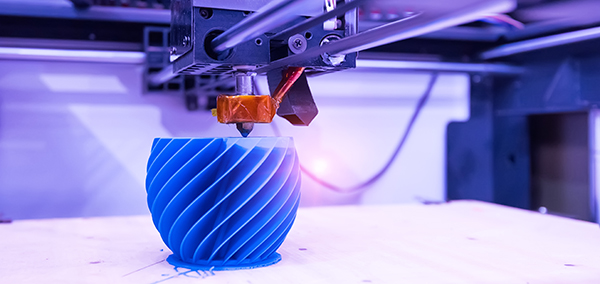Keeping abreast of the emerging trends in manufacturing.
Looking to ride the wave of the fourth industrial revolution? This trio of trends could be the wind in your sails.
As the saying goes, ‘they don’t make them like they used to’. Over the years, the types of products available in the market have evolved, and so have the methods used to create them. Technology has been a key driver of these changes, enabling enterprises to manufacture increasingly complex and valuable items with extraordinary precision and efficiency.
Amidst this landscape of disruption, certain trends have emerged that help leading business stay ahead of the curve in the manufacturing industry. We highlight three of them—digitalisation, robotics and additive manufacturing—in this article.
Dancing with digitalisation
In the same way the steam engine powered the first industrial revolution in the 19th century, the internet cuts across all aspects of enterprise in the 21st century. Digitalisation is eating the world, and the manufacturing sector has not escaped its jaws, heralding the dawn of Industry 4.0.
At the core of the digitalisation of the factory floor is the Internet of Things (IoT). According to a report citing the International Data Corporation’s analysis, the total investment in IoT by the manufacturing industry in 2016 is estimated at US$178 billion. The Asia-Pacific region, excluding Japan, is expected to lead IoT spending, with its manufacturing sector accounting for almost one-third of IoT procurements. This is a strong indication of the immense potential that IoT has to offer in augmenting the manufacturing process.
Using IoT technology, factory equipment and machinery no longer function as independent units but are connected to one another via the cloud. Data is generated across the value chain in real time, and even the manufactured end-product provides feedback on its performance in the hands of the consumer. Leveraging this data, manufacturers can generate insights to continuously refine their product design and assembly line, allowing them to provide consistent value to consumers and improve productivity.
In Singapore, Feinmetall Singapore Pte Ltd recently opened a S$6 million digital manufacturing plant that boasts a suite of digitalisation technologies, including an Overall Equipment Effectiveness Monitoring System and a Maintenance Management System. By analysing machine data, Feinmetall is now able to schedule equipment maintenance to pre-empt stoppages, thereby significantly reducing operational downtime.
Relying on robotics
Whereas in the past, assembly lines were run by humans, robots now line the factory floor, putting complicated devices together with uncanny precision. With increasing dexterity, speed and ‘intelligence’, these tireless automatons complement human workers in the execution of tedious, repetitive or dangerous tasks in the manufacturing sector.
It has been estimated that the market for robots worldwide will amount to US$135.4 billion in 2019, with manufacturing and healthcare sectors leading the adoption of robotic technologies and related services. A PwC survey showed that 59 percent of all manufacturers are already using robots in their operations. The Asia Pacific is also one of the fastest growing regions in integrating robotics into its manufacturing industries.
To drive the exploration and adoption of robotics solutions and Singapore, the government announced in 2016 that it is committing more than S$450 million to the National Robotics Programme. In addition, robotics supplier ABB runs a Regional Robotics Packaging Application Hub in Singapore, collaborating with local and regional enterprises in the food and beverage, pharmaceutical, consumer electronics and solar cell manufacturing sectors to develop customised industrial robots. The Robot Operating System (ROS)-Industrial Asia Pacific Consortium also has an office at A*STAR’s Advanced Remanufacturing and Technology Centre to assist in co-creating software solutions for the operation of robots in manufacturing settings.

Adopting additive manufacturing
Early methods of creating prototypes in the manufacturing sector required milling, moulding and machining, methods that were time-consuming and costly. Enter additive manufacturing, more colloquially known as 3D-printing, wherein material is successively added according to a computer-modelled design to eventually produce a 3D object. Hence, no material is wasted, and intricate product shapes and designs can be easily crafted.
According to a 2016 report, the 3D-printing market globally has grown steadily at a rate of 28 percent from 2011 to 2015, and a strong annual growth of 25 percent is expected to continue until 2020. Importantly, the manner in which companies use 3D-printing has shifted. Rather than simply create the prototype during the design phase of production, 3D-printing is increasingly used to manufacture the actual product. This means that 3D-printing is becoming recognised as a method of manufacturing, complementary to traditional forms of manufacturing. At the same time, more materials are made available for 3D-printing applications. Some of these materials are further customised with unique properties for specific purposes are being developed.
Recognising the potential of 3D-printing, Singapore set up the National Additive Manufacturing Innovation Cluster (NAMIC) in 2015 to enhance the 3D-printing capabilities of local enterprises. Since its inception, NAMIC has worked with more than 380 industry and institute partners on projects in six focus areas. Another S$18 million was recently dedicated to the National University of Singapore Centre for Additive Manufacturing (AM.NUS) which is geared towards 3D-printing surgical tools, implants, medicines and even living tissues.
As these three forces—digitalisation, robotics and additive manufacturing—continue to shape the manufacturing sector, enterprises can keep up with the fourth industrial revolution by adopting an open innovation mindset. Rather than create new software or robots from scratch, companies can tap into external expertise to accelerate their uptake of these trending technologies. Should business owners be uncertain of how to find a suitable partner for technical innovation, they can approach IPI Singapore for customised tech-matching services.
